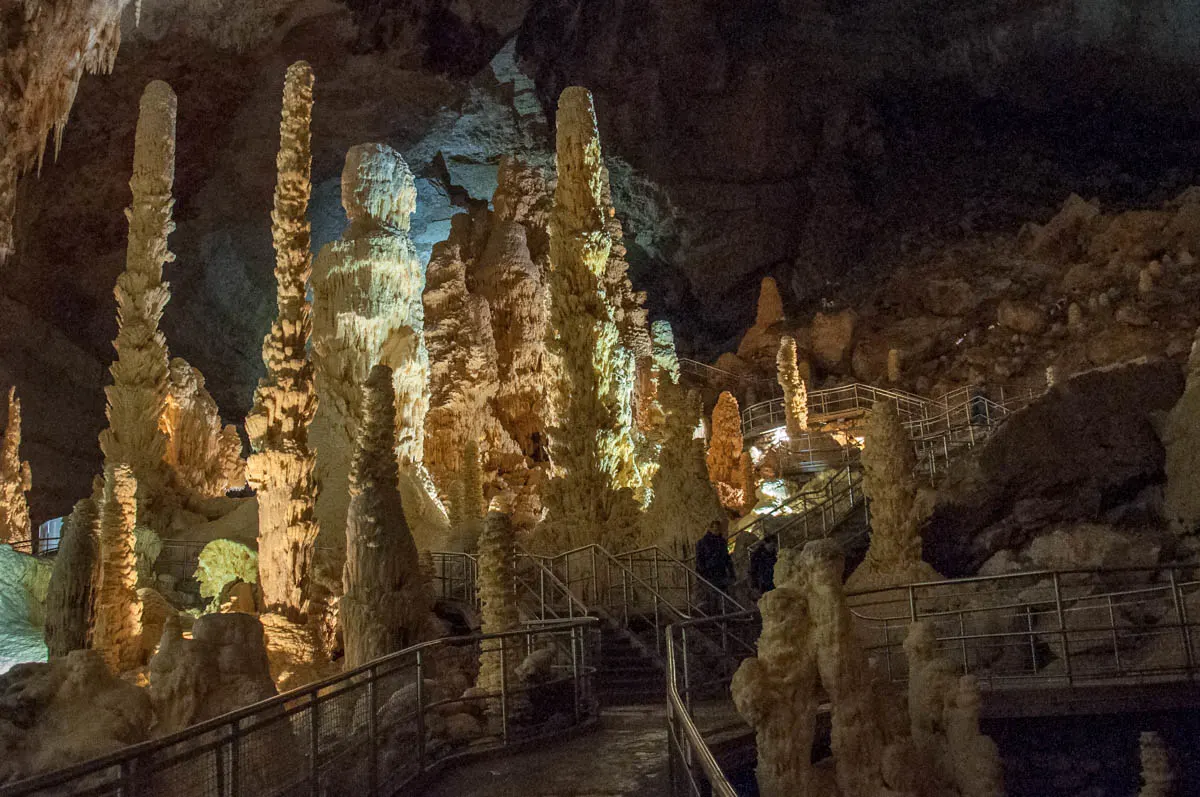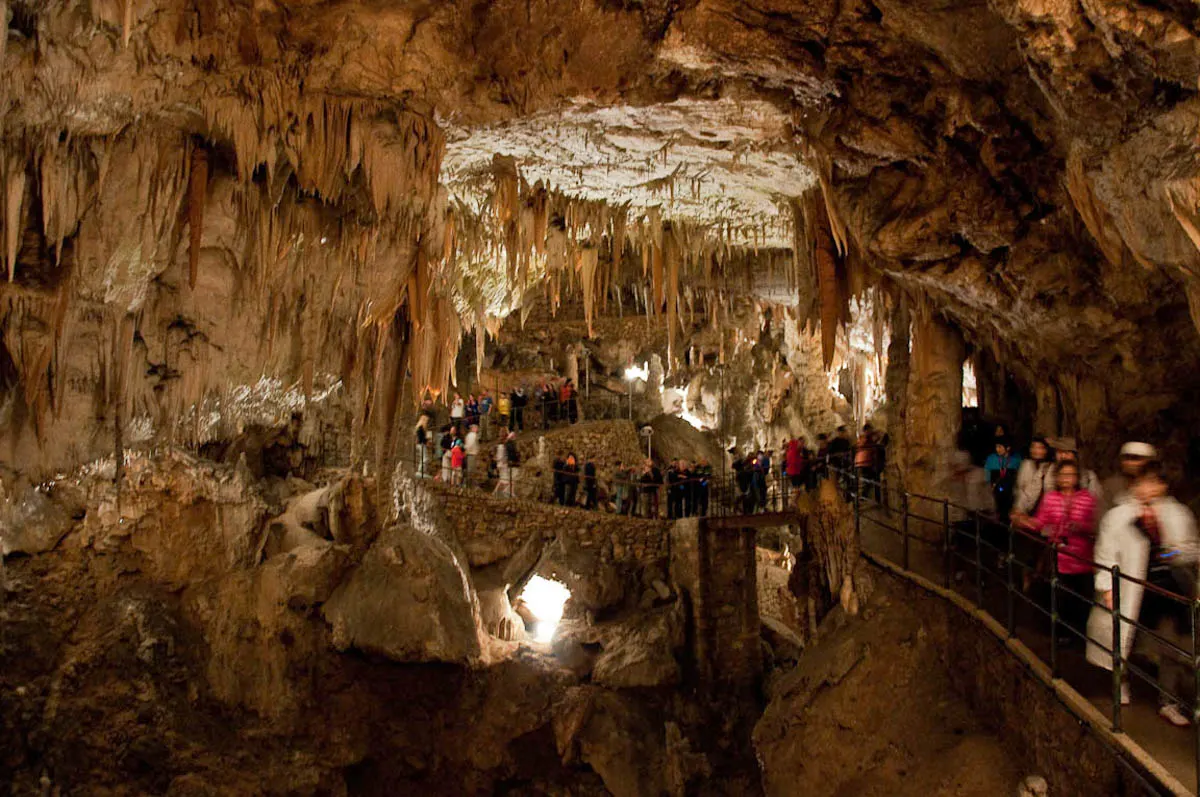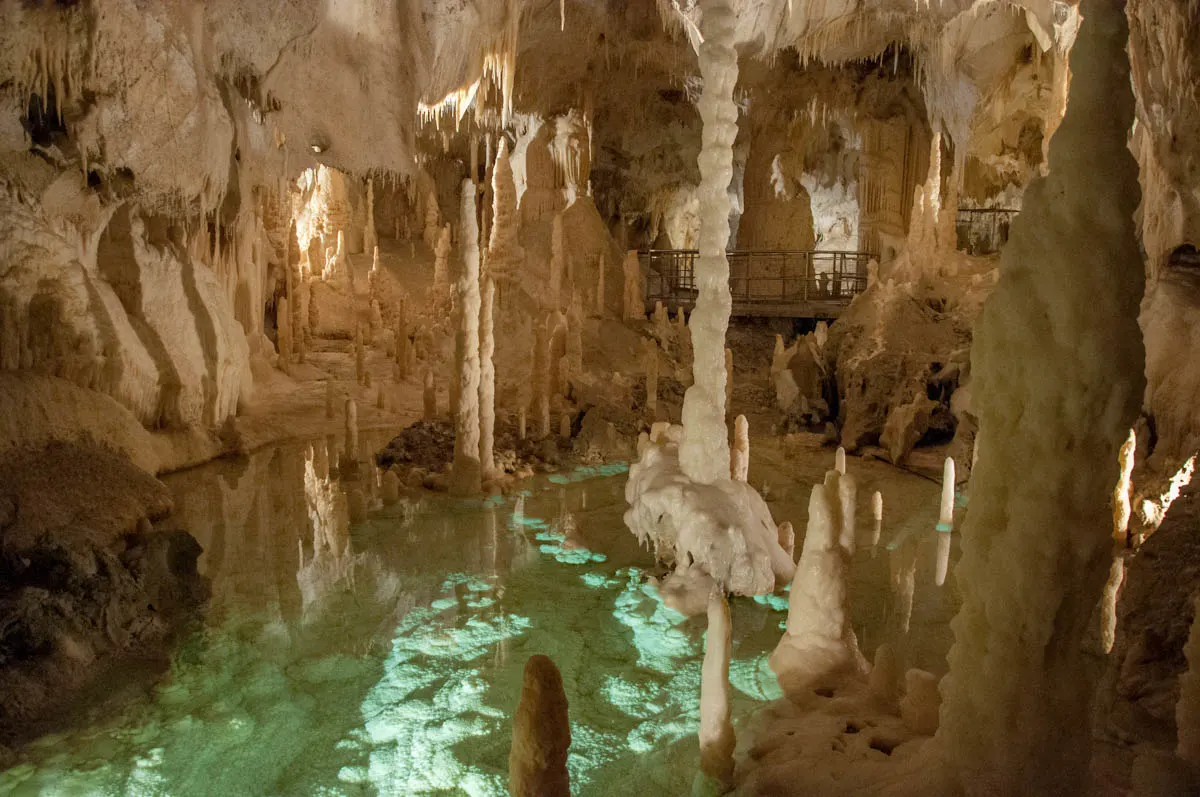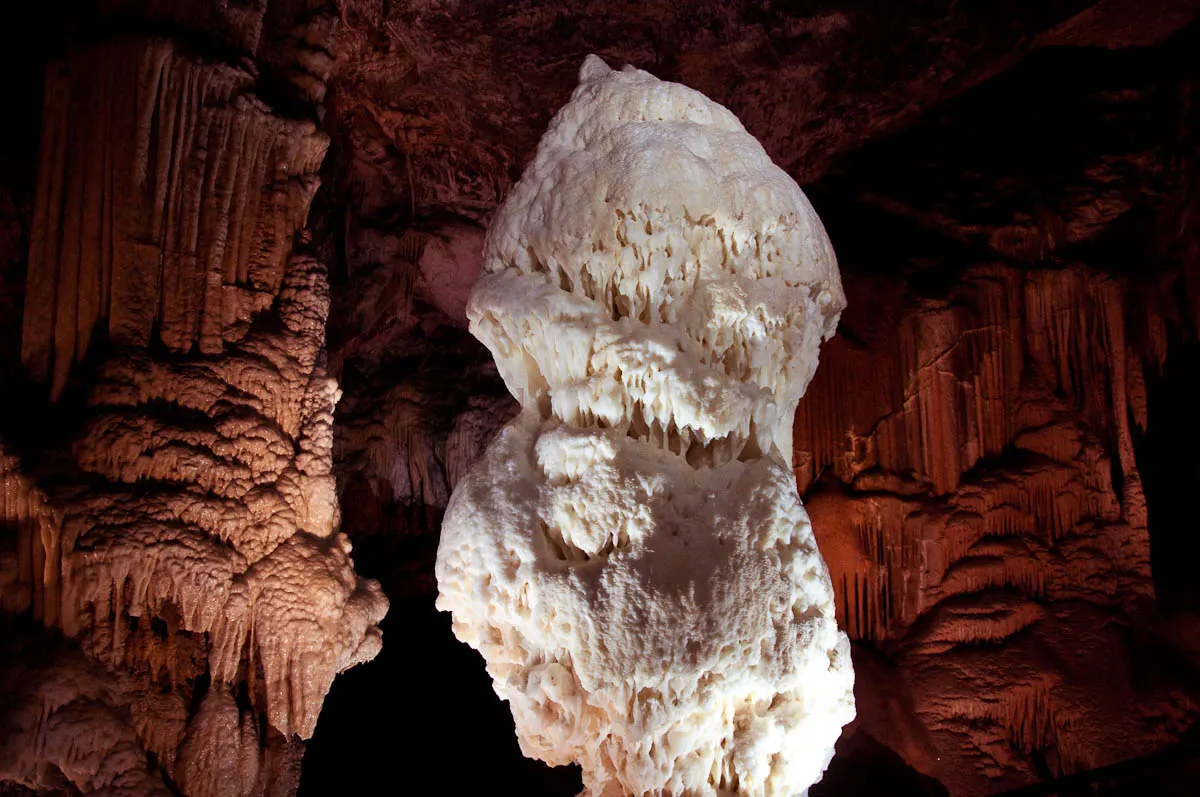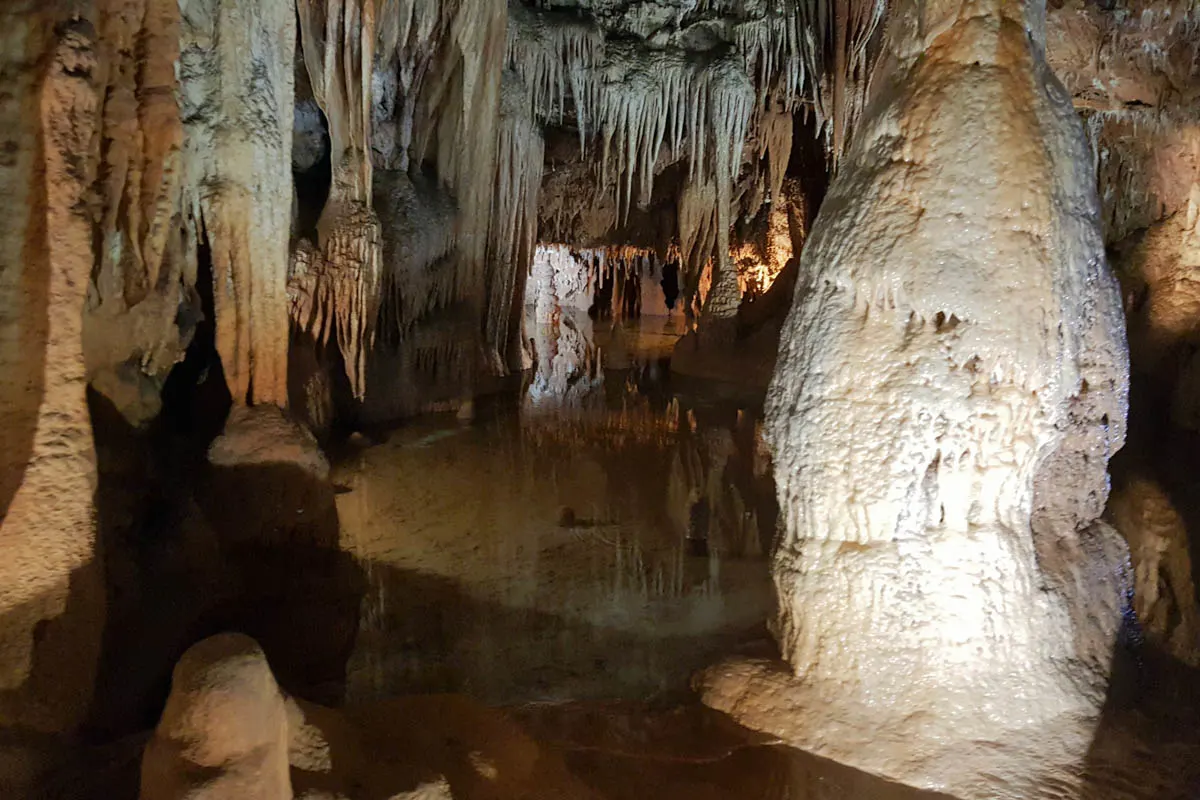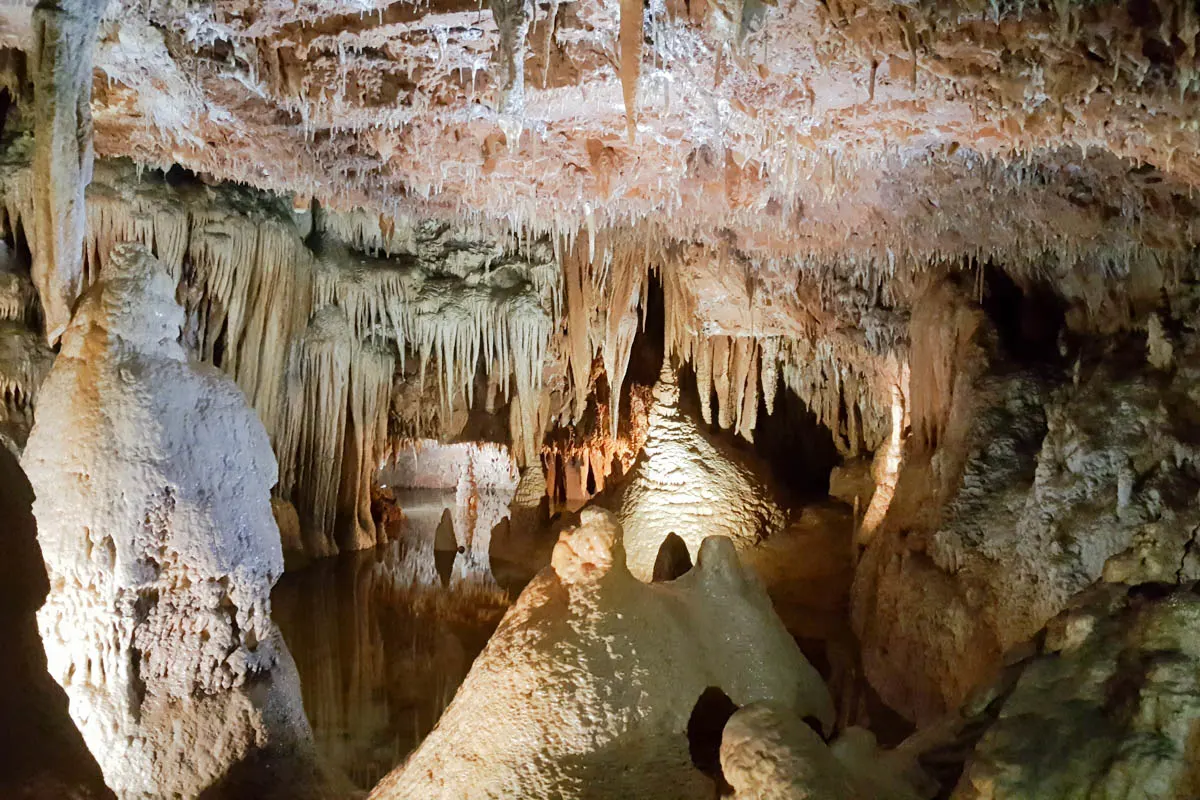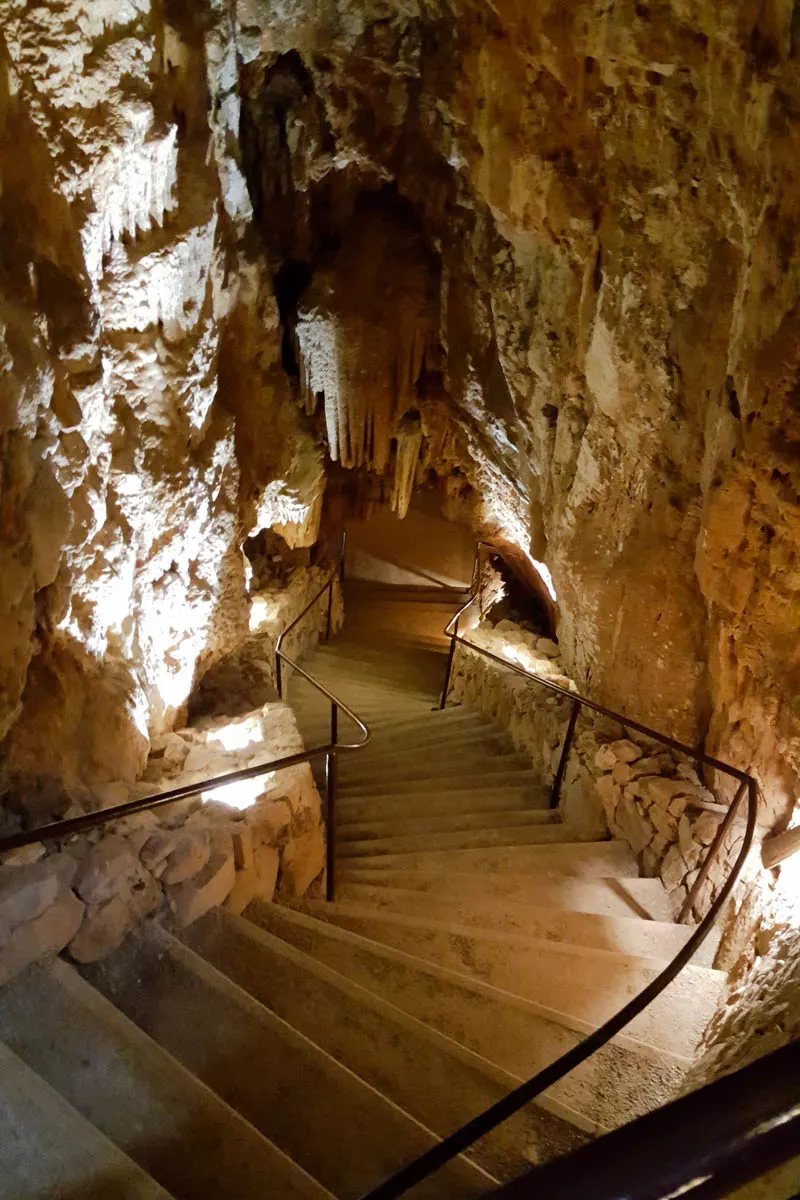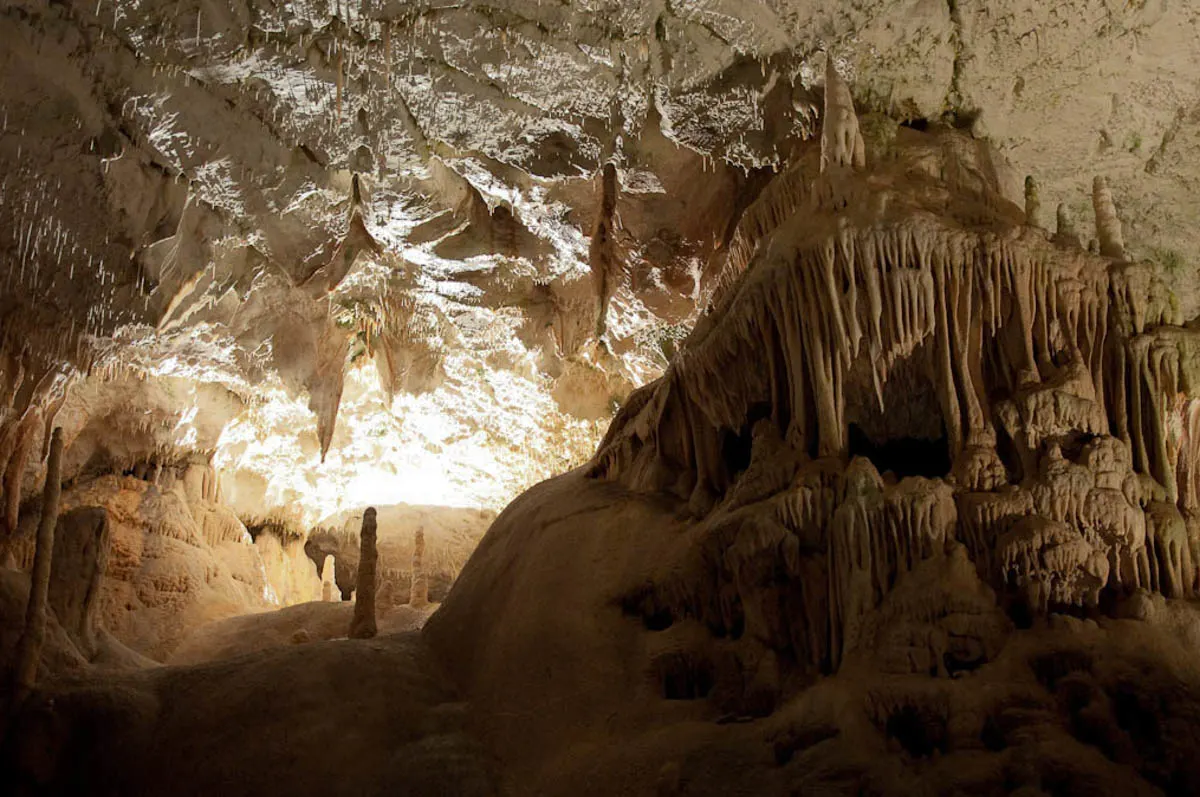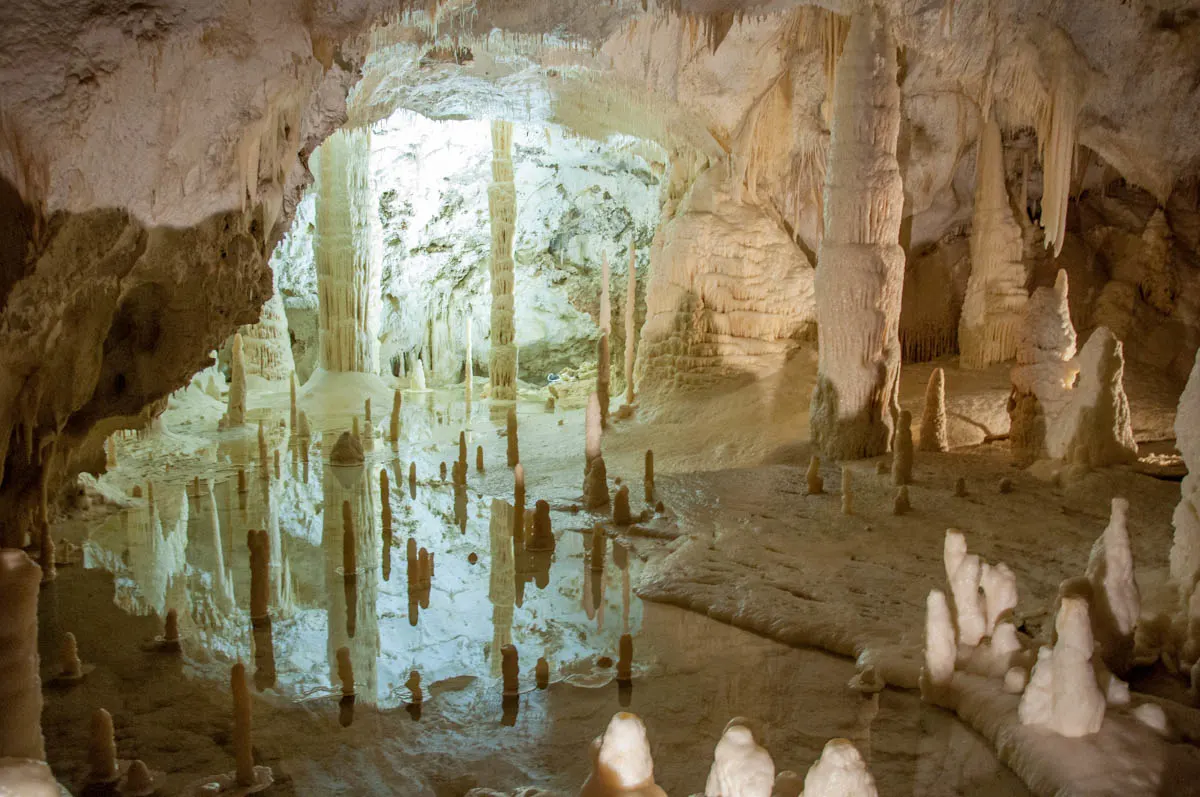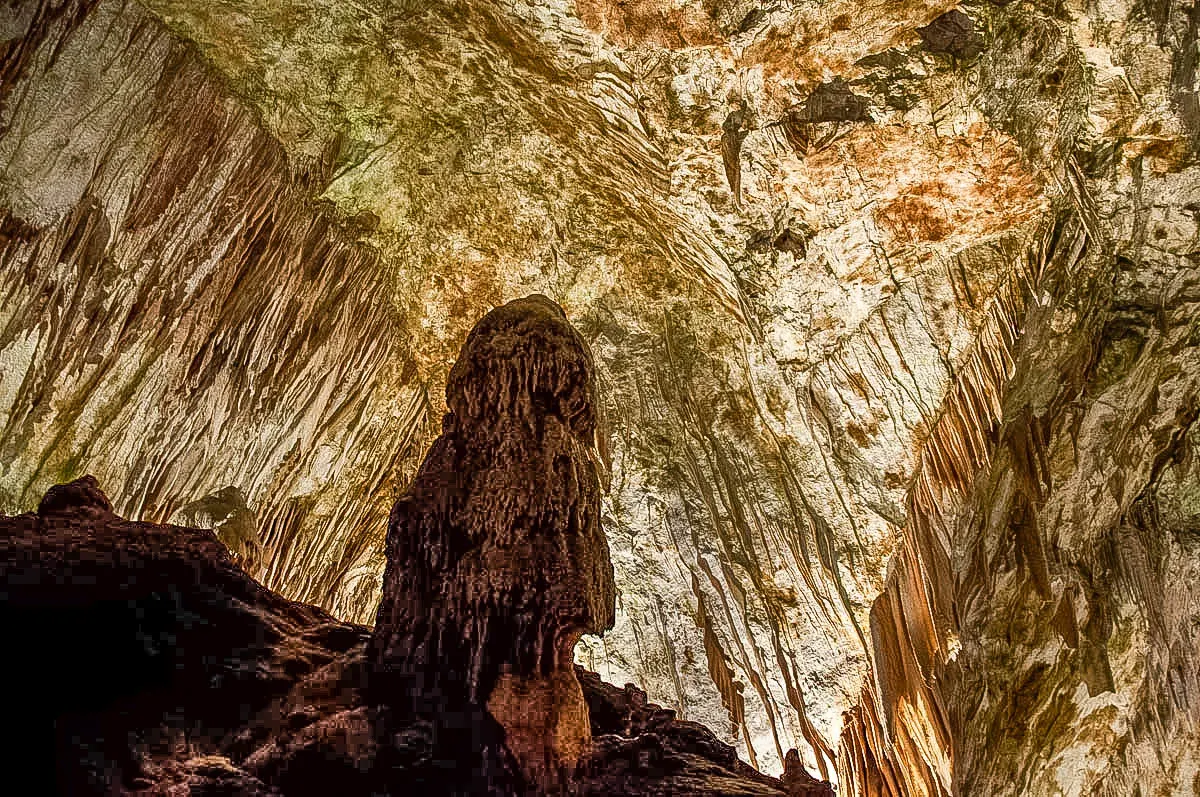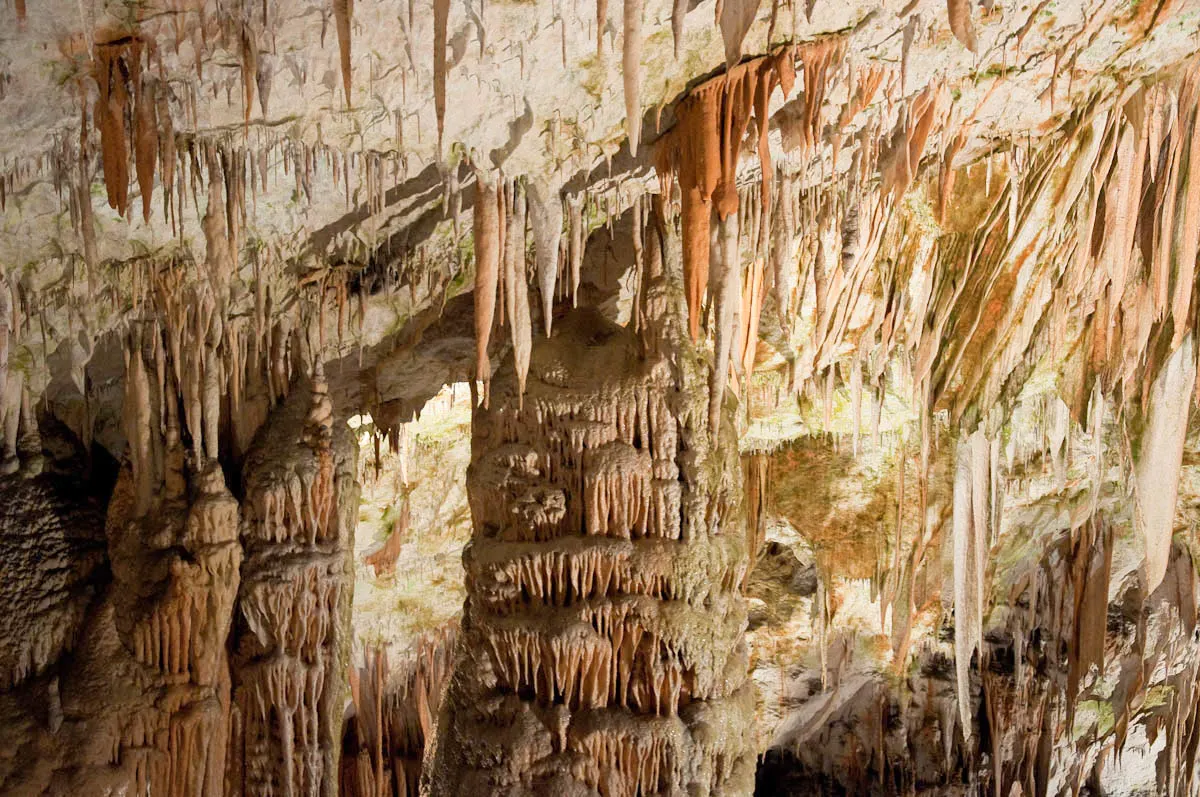Have you considered cave exploring as a family adventure to experience this year?!
It sounds like such a daring enterprise with an element of danger and requiring lots of specialised equipment. Yet, there are many tourist caves in Europe where you can simply stroll in and out as easily as walking in the park. Surrounded by whimsical formations and led by an expert guide, you and your kids will soon discover a new passion for caves and their underground beauty.
To start you off on this path, here are three of the most striking caves in Europe you can easily explore with your family in tow. These are the Frasassi Caves in Italy, the Postojna Cave in Slovenia, and the Baredine Cave in Croatia. All three are relatively close to one another so that, if you so wish, you can see them all in one glorious caving road trip across three countries.
All three are tourist caves (also called show caves). In other words – caves which are open to the general public and where a guide takes a group of paying visitors on a walk through the cave chambers. These are equipped with walkways, lights, and maybe even a train – as it is the case in Slovenia’s Postojna Cave.
Below I have provided lots of interesting information to spark your curiosity about the Frasassi, the Postojna, and the Baredine caves. What to see in each, how the visit is organised, and what are some nearby sights to explore on the same day, everything is covered.
Right at the end of this blog post, you will also find many practical tips to make your exploration of tourist caves in Europe with your family an adventure to remember and replicate over and over again.
Now, let’s dig in!
3 Caves in Europe to Easily Explore with Your Family This Year
1. Frasassi Caves – Italy
Italy has many underground treasures and the Frasassi Caves are, indeed, one of the most precious gems in her crown. This large karst cave system is in the Central Italian region of the Marche and it was discovered by chance in 1971. It consists of a series of breathtaking chambers. One of them – the so-called Ancona Abyss – is so cavernous that Milan’s Duomo can fit inside it without any problems.
The Frasassi Caves are open for visitors and are a pleasure to explore with kids in tow on a guided visit. You can buy your tickets online in advance or on the day. The ticket office is surrounded by a specially built huge parking lot where you need to leave your car. It is just under two kilometres away from the caves’ entrance but don’t worry as there is a shuttle bus. Right behind the parking lot is the Genga/San Vittore Terme train station.
Bear in mind that during the high season, the Frasassi Caves attract a large number of visitors, so plan accordingly in terms of parking and queueing. If you buy your tickets online, you still need to go to the ticket office to collect them. We visited the caves at the beginning of March and even though the parking lot seemed almost empty, there were about forty people on the tour itself.
Align for the shuttle bus about half an hour before the time slot of your visit. The bus will take you together with the rest of the people on the same timed tour to the entrance of the caves. The tour guide will meet you there and introduce you to the story of the Frasassi Caves, how they were discovered and what their geology is. The temperature inside the caves is a constant 14 degrees Celsius.
A visit to the Frasassi Caves lasts around 75 minutes and it’s a truly charming experience. The cave chambers are lined with thousands of stalactites and stalagmites. Several crystal clear ponds are dotted along the way. Whimsical formations catch your eye at every step and turn. At one point, you find yourself walking on a long thin bridge with ponds on one side and a long drop on the other. In the dim light, it feels like you are in a charmed kingdom where fairytale creatures steal a peek at you and swiftly hide right before you spot them.
The stories told by the guide about the discovery and the exploration of the caves awake your curiosity about what’s hidden underground. Plus, you cannot help it but laugh when she points to the Pancetta Slice and the Lard Slice – two of the most famous formations in the Frasassi cave system.
More Information: For opening times, directions and other useful info, please, check the official website of the Frasassi Caves here. For more ideas as to what to do in the Central Italian region of the Marche, please, click here.
What Else to See in the Vicinity: The ticket for the Frasassi Caves also gives you free entry to a number of other sights and small museums in the immediate vicinity. For example, there is a pretty Roman bridge over a sulphurous river and a tiny museum halfway between the parking lot and the entrance of the caves. The shuttle bus can drop you there on the way back from the cave visit.
The small village of Genga is just under seven km away from the Frasassi Caves and it has a very interesting museum to explore. One of its rooms tells the story of the Venus of Frasassi – a tiny statuette which is one of Italy’s most ancient examples of art from the Paleolithic period.
The Frasassi Caves are in the Regional Natural Park of Golla della Rossa e di Frasassi where there are many hiking routes, smaller caves, and other spots of natural beauty to enjoy.
My favourite local sight is the Temple of Valadier – an octagonal church built in the mouth of a rocky cave in the face of a steep cliff. Right next to the Temple of Valadier is the Sanctuary of Santa Maria Infra Saxa which has been attracting pilgrims for over a thousand years.
Click here to read more about the Temple of Valadier and many other wonderful things you can see and do in the Central Italian region of the Marche.
2. Postojna Cave – Slovenia
The Postojna Cave is stunning! Just a touch over 24 km long, this underground karst system is like a cathedral built by nature. With its huge chambers staffed with enormous stalactites and stalagmites, with its narrow passages curving through the dim lights, and with its fast-running river, the Postojna Cave leaves you breathless at discovering the beauty and the might of the underground world.
The Postojna Cave is in Slovenia and it is one of the country’s most well-known sights. It attracts over three-quarter of a million visitors each year and a whole complex with hotels, bars, restaurants and a huge parking lot is built around the cave. The different types of tickets can be bought online or on site and are for a particular time slot. The cave is very popular so in high season plan your visit in advance.
Tours are held in a number of languages and a warm cloak can be rented to keep you cozy on the train ride and the walk through the cave. The temperature inside is a constant 10 degrees Celsius year round.
The visit lasts about an hour and a half. You need to present yourself at the cave entrance at least ten minutes before your ticket’s time slot. Bear in mind that the ticket office is at some distance from the actual cave entrance, so don’t leave it until the last minute to walk there. Even if you pay online, you still need to collect your actual tickets from the ticket office, so allow plenty of time for this.
The tour of the Postojna Cave starts with a ride on a small open-top train. It takes you on a breathtaking journey through a series of stunning chambers shaped in complete darkness by mother nature over hundreds of thousands of years. Just make sure that you stay seated all the way through and don’t stick your arms or legs outside of the train’s tiny compartments.
Once you get off the train in the middle of the cave, the walk back to the exit follows a wide concrete path that has been laid through the cave’s chambers and passages. The path is smooth and very easy to walk on. There is one steep inclination right at the start of the walk, straight after you have gotten off the train. This is the highest point of your exploration and it reaches 40 meters.
I saw someone with a walking stick managing it with quite some difficulty. Otherwise, the path is very easy to follow, but the walk in itself is long. The guide talks you through the different chambers you see on the way. As the group is large, it may be difficult to constantly keep up with the guide, though.
At the end of the walk, you will see a large dark aquarium where a number of olms live. An olm (also called a proteus and a human fish) is a type of an aquatic cave-dwelling salamander. It has a long body and an almost translucent skin. As it lives exclusively in darkness, it doesn’t have eyes and it uses its skin to sense its environment. It is explicitly forbidden by law to take any pictures of the olms at Postojna Cave, as it can interfere with their reproductive process.
There are many amazing natural sights to be seen and enjoyed in the Postojna Cave. The underground river Pivka is one of the most impressive ones.
More Information: For opening times, directions and other useful info, please, check the official website of the Postojna Cave here. You can also have a look at my blog post Visiting the Postojna Caves in Slovenia with a Toddler – Tips for Parents. It has a lot of first-hand tried and tested information as to how to make your visit to the cave easier if you are travelling with a baby or a toddler.
What Else to See in the Vicinity: Predjama Castle is the most well-known sight in the immediate vicinity of the Postojna Cave. This eight-centuries old castle is half-built inside a cave on the face of a steep cliff. It’s stunning to see and explore.
The Slovenian capital – Ljubljana – is less than three-quarters of an hour away. And from there you can continue to Slovenia’s other gem – the beautiful Lake Bled – as well as to the nearby Triglav National Park for some lovely views and hiking.
Alternatively, from Postojna Cave you can easily cross into Italy and explore the exciting Italian city of Triest with its historic coffee houses and the nearby Miramare Castle.
3. Baredine Cave – Croatia
I loved visiting the Baredine Cave on the peninsula of Istria in Croatia. It will certainly take the top spot for me if I am very hard pressed to chose a favourite one from the three caves listed in this blog post.
Unlike the Frasassi Caves and the Postojna Cave, the Baredine Cave is small, compact and goes straight down into the ground as it is a sinkhole. Its entrance is literally a large hole in the flat ground. You start the visit by descending deeper and deeper following a set of very steep steps that go perpendicularly in the soft red Istrian soil.
Once truly underground, the guide takes you through a series of five chambers – each one at a lower level than the preceding one – down to a depth of 60 m. At the end of the 300 meters-long trek, there is a picturesque small lake and a tiny pond with a couple of olms in it. You get a chance to have a really close look at these unusual creatures. When we visited, there were three olm babies and a mother olm in the pond which, considering how rarely these animals breed, was quite amazing to see.
As we visited Baredine Cave around Easter – right before the start of the high season – our group was very small. It was just us and another couple, so the guide was able to spend a good portion of the 40 minutes-long visit answering our many questions and telling us some very interesting stories about the Baredine Cave and the Istrian peninsula.
Istria is home to 2,000 known caves, pits, and sinkholes. Only five of them are open for visitors nowadays, one being the Baredine Cave which has been accepting tourists since 1995. The guided tours are held in a number of languages and start every 30 mins. While the cave has been explored to a depth of 132 m, tourist visits go down to a depth of 60 m. underground.
The Baredine Cave has been known to the local people for many centuries. Apparently, they were scared of it and stayed firmly away using it to throw inside things they no longer needed.
Recent explorations have discovered that prehistoric people used to live in the Baredine Cave. So, next to its entrance you can see a nice little exhibition on the topic of ancient cave-dwelling civilisations. There is also an adventure pit where you can test your skills as a speleologist by climbing up and down its vertical walls.
The Baredine Cave has an on-site restaurant and it is surrounded by olive groves and vineyards. It is a pretty and peaceful area, a stone’s throw away from the nearby Croatian towns of Porec, Rovinj, and Pula.
More Information: For opening times, directions and other useful info, please, check the official website of the Baredine Cave here. Click here to see a video of the deepest point of the Baredine Cave on my blog’s Facebook page. Please, could you also like my blog’s Facebook page, while you are there?! Thank you!
What Else to See in the Vicinity: Just opposite the Baredine Cave, you’ll find Tractor Story – Croatia’s first permanent exhibition of old-time tractors.
25 mins away from the Baredine Cave is another gorgeous tourist cave worth exploring. It’s called Mramornica – the Marble Cave – and you can find more details about it here.
Alternatively, head straight for the nearby towns of Porec, Rovinj, and Pula to explore Roman ruins, ancient and medieval temples, a Venetian fort and many gorgeous sea views.
Practical Tips and Tricks about Visiting Tourist Caves as a Family
1. What do I need to know in advance before visiting tourist caves in Europe as a parent with my children?
Tourist caves are open to the general public and a lot of work has gone into making them safe and comfortable to visit. Walkways, stairs, and bridges have been placed inside in order to make it possible to easily advance from one cave chamber to the next. Visitors are allowed in as part of a paid for guided tour. The guide tells the story of the cave and provides curious details about its formations and the organisms which may call it home.
Here is some useful information to know in advance if this will be your and/or your children’s first visit to a cave:
- constant temperature – as caves are underground, usually, the temperature inside them is constant. This may mean 10 or 12 degrees Celsius no matter if it is scorching or snowing outside. Some larger caves, like the Postojna Cave in Slovenia, may rent cloaks out to visitors which, especially in summer, may come in very useful. It is not a pleasant thing to spend a visit to a cave shivering, so bring a light hoodie or a jumper if you think that you or your children may need one during the visit.
- follow the guide’s instructions – the guides are there to show you the cave’s wonders but also to make sure that both the group and the cave remain safe during the visit. As such, please, follow strictly his or her instructions no matter how much you may want to do something else.
- no touching – it is strictly forbidden to touch the formations inside the cave. These can be stalactites, stalagmites, stalagnates, and so on. It takes an incredible amount of time to create these wonderful and whimsical formations. Interfering with them in any way may irreversibly damage them. Even a light touch may be really harmful to them as the oils in the human skin may make it impossible for the tiny drops of water which make the cave formation grow continue to cling or flow at their usual place and speed. This way, the growth of the formation will be forever changed or even stunted. Our hands also bring outside bacteria into the cave environment and dirt on fingers can stain or change the colour of cave formations.
- dim light – tourist caves are equipped with lights along the path followed by the group. The light is dim though. Your eyes will quickly adjust to it but you need to mind your step during the walk.
- wet patches on floors – the wonderful cave formations have been built by water over hundreds of thousands of years. Expect to see water during your visit to a tourist cave. From tiny droplets to streams and even underground lakes and fast rivers, water takes many and all shapes inside the cave environment. As such, the floor of the walkway may be wet at places.
- steps – there may be steps or steep inclines to manoeuver during your visit to a tourist cave. Its chambers have been adapted as best as possible to accommodate visitors. Yet, at times, and in order to pass from one chamber to another inside the cave, a difference in heights is made possible to overcome with a set of steps. If one of your party has reduced mobility, please, contact the tourist cave a visit to which you are considering and ask if they can accommodate you before travelling there.
- food and water – usually, it is not allowed to bring food and water inside a tourist cave. A visit – depending on the cave size – may last from 40 mins to over two hours. Please, plan accordingly. Usually, tourist caves have a restaurant or food kiosks in their immediate vicinity so you can easily have something to eat and drink before or after your visit.
- toilet breaks – there are no toilets inside tourist caves but toilet facilities will be provided by their entrances/exits.
2. What can I do to make sure that my children are safe and comfortable during a visit to tourist caves in Europe?
If this will be your children’s first visit to a cave, it may be a good idea to spend a few minutes in advance discussing what you will see there. For example, you can explain that your family will explore a magical underground world with lots of beautiful formations to see and admire. You can show photos of the tourist cave to your children and introduce them to words such as stalactite and stalagmite while explaining how these are formed.
Of course, it all depends on your children’s age and interest in science and adventure. So, make it as magical or as scientific-based as they would like it to be. In any case, explain that it is strictly not allowed to touch the cave formations during your visit.
Consider that the temperature inside the cave is constant and (especially in summer) bring a light jumper or a hoodie or two in case one of your children needs it. Make sure that everyone has eaten in advance and that toilet breaks have been had by all right before going inside the cave.
Consider bringing a baby carrier or, if the cave allows it, a buggy to make it easy for little feet to navigate the trail. In case you decide to use a baby carrier, consider having a front-facing one, as the ones that are carried on the back may be more difficult to maneuver in tighter spots along the track and you don’t want to swipe a millennia-old stalactite as you walk along.
Hold younger children by the hand and help them navigate steps, inclines, and wet patches along the trail.
A visit to a tourist cave can be a wonderful adventure for kids. Yet, if it is their very first one, be aware that they may find this new world a bit unusual and even unsettling.
When we first took our little daughter to a cave – the Postojna Cave in Slovenia – she found it a bit overwhelming and requested that I carry her all the way through. We have now visited several tourist caves as a family and it’s an experience enjoyed by all three of us.
3. Where can I find more ideas for tourist caves to visit in Europe?
A good starting point is this Wikipedia list of caves in Europe. It’s organised by country so you need to click on the different countries’ names to find more information about the caves in each one.
N.B. Please, only take your family to caves which are officially open to the general public and provide a guide to take you safely in and out. Tourist caves (also called show caves) are equipped with walkways, stairs, lights, maybe even music, lasers, and/or a train. You also need to pay an entrance fee.
4. Can I take photos and videos inside tourist caves in Europe? What is the photo etiquette inside tourist caves in Europe?
Please, make sure to ask the guide if photos and videos are allowed in the tourist cave you are visiting. If the answer is no, please, don’t try to flout the ban by sneakily taking a photo here or there. There may be some very important reasons behind it like not disturbing the cave’s fauna and/or avoiding that people lag behind the group.
If photos are allowed, then try to keep up with the group instead of lagging up behind trying to take a perfect photo or two. Don’t stick your camera or your phone over railings and definitely, don’t lean over the railings yourself. The drop on the other side may be significant. If you drop something, it will not only be lost to you but, on its way down, it may break and damage stalactites and stalagmites that have taken thousands of years to develop.
Bear in mind that the light sources inside tourist caves are rather dim. You may need to crank the ISO significantly in order to manage to take photos with some speed. Tripods are usually not allowed as the guide is there to make sure that the whole group progresses at the same speed and stays together instead of allowing time for you to take professional shots.
Selfie sticks are a great no-no. Waving them around in the dim light is a recipe for disaster.
If you are busy taking photos and videos inside the cave (provided this is allowed), make sure that your children are not left unsupervised in the meantime. Someone – another parent, partner or relative – needs to be with them at all times, making sure that they are safe and comfortable.
Everyone in the group will want to take photos (where allowed) inside the cave. The environment is beautiful and unusual and people get excited about capturing it all. Don’t push other people aside trying to get the best shots first. Don’t tut-tut when other people are taking their time at the exact spot you are angling for. Beware of steps and slippery surfaces. Don’t walk with the camera in front of your face. Don’t ask people to move away so that you don’t have anyone in your photos’ backgrounds.
Remember that you all have paid an entrance fee and have the same right to enjoy the cave environment respectfully. Also, you are in a group in a small space underground, sometimes up to an hour or an hour and a half from the nearest exit. Do you want the tempers to flare or to leave a bad impression?!
In Conclusion
Cave exploring is a great adventure to have with your family. Provided, of course, you visit tourist caves which are open to the general public and there is a guide to safely take you in and out following a sturdy path securely laid through the cave.
There are many beautiful and exciting tourist caves to be seen and explored in Europe with kids in tow. In the above blog post I recommend three of them in Italy, Slovenia, and Croatia. I also outline many curious details and useful information to make your visit to these tourist caves a wonderful and memorable experience for you and your children.
The Frasassi Caves in Italy, the Postojna Cave in Slovenia, and the Baredine Cave in Croatia are very interesting to visit and are great places to take your children to. Differing in size and with exciting stories about how they came to be, a visit to one or all three of them is a must-do if you are in the vicinity.
N.B. Please, only take your family to caves which are officially open to the general public and provide a guide to take you safely in and out. Tourist caves (also called show caves) are equipped with walkways, stairs, lights, maybe even music, lasers, and/or a train. You also need to pay an entrance fee.
More Helpful Links
- Visiting the Postojna Cave in Slovenia with a Toddler – Tips for Parents
- Marche, Italy – 6 Reasons to Visit Italy’s Most Underrated Region
- The Painted Caves of Rubbio, Italy – Where Art Meets Nature
- 5 Things to Do in Piran, Slovenia if You Only Have Half a Day
- Best 12 Towns to Visit Around Lago di Garda – Italy’s Largest Lake
- Day Trips from Verona – 16 Destinations to Fall in Love With (With Travel Times and Train Tips)
- Day Trips from Padua, Italy – Over 35 Unmissable Destinations in the Veneto, Lombardy, and Emilia-Romagna
- Day Trips from Vicenza, Italy – Over 90 of the Best Destinations
- 11 of the Best Day Trips from Venice (With Lots of Photos, Travel Times and Italy Train Tips)
- Trentino, Italy – Castles, Hikes, and Alpacas – The Perfect 4-Day Itinerary (With or Without Kids)
- 20 Family-Friendly Walks and Hikes Up to an Hour and a Half from Vicenza, Italy – First Part
- 20 Family-Friendly Walks and Hikes Up to an Hour and a Half from Vicenza – Second Part
Do you like to explore tourist caves with your family? Have you been to one or more of the three caves in Europe listed above? What were your personal impressions? Which tourist caves in Europe or anywhere in the world, for that matter, would you recommend that I visit? Let me know in the Comments section below.
Thank you for reading! Please, leave me a comment, pin the image below or use the buttons right at the top and at the end of this blog post to share it on social media.
For more useful information like this, please, like my blog’s page on Facebook and subscribe to my weekly strictly no-spam newsletter.

